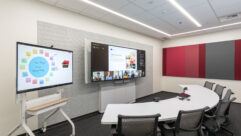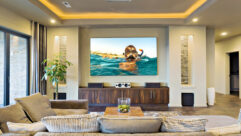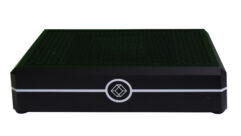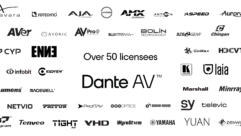
The annual Adobe Digital Marketing Summit (Adobe DMS) is renowned for the visual “wow factor” it delivers to thousands attending its keynote sessions at Salt Lake City’s Salt Palace Convention. For the third consecutive year WorldStage provided AV support for the summit’s giant panoramic canvas, which dominated the venue’s Keynote Room.

Held March 9-13, Adobe DMS presented thousands of attendees with the latest strategies and information designed to increase their knowledge and grow their business through digital marketing. Keynote speakers included FiveThirtyEight.com founder Nate Silver; actor Michael Keaton; climber Tommy Caldwell; Girl Scouts of the USA CMO Sarah Gormley; and FEED Projects founder/CEO Lauren Bush.
PIX PRODUCTIONS, with scenic designer Peter Crawford, created the kind of visual impact that Adobe DSM attendees have come to expect. Three main screens presented a landscape canvas supporting guest speakers, Adobe executives, and software and tech demos on stage. Four more delay screens ensured that demo details were clearly visible to the entire audience, which was seated in a semi-circle.
This year the backdrop to the keynotes was a 12,000-pixel wide display comprising 251×26 feet of linear projection surface. The main screens alone displayed more than 43 million pixels – the screens’ sheer size and scale packed an impressive visual punch.
“Adobe is a technology leader, and its DMS conference mirrors that high level of technology,” notes WorldStage project manager Jack Dussault, who previously teamed with PIX PRODUCTIONS on Adobe MAX 2014 The Creativity Conference last fall. “Seamlessly meshing dozens of computer sources into a cohesive presentation across a panoramic canvas has become routine for us. While the technology required gets complicated, our experience helps us avoid any pitfalls.”
This year WorldStage provided a 92×24-foot Stewart Film Screen as the main center screen. “It’s a one of a kind seamless .9 gain rear-projection screen,” says Dussault. “We hadn’t used rear projection for this conference, but we decided to try it so presenters could stand directly in front of it.” Content was displayed using a three-screen blend.
Flanking the center screen were left and right front projection screens supplied by the scenic company and measuring 83×26 feet each. These screens slightly overlapped the center rear screen and had scalloped edges that created a unique effect. Each featured a two-screen front projector blend with Christie projectors.
The main screens displayed seven video feeds processed by two Vista Systems’ Spyder X20s: one to control the content of the main center screen and one for the two outer screens; a third Spyder was on hand as a back up unit. “Forty computers, the camera switcher, the graphic computers — all these sources went into the Spyders,” Dussault says. To send moving video to the screens the Spyders processed a staggering 435 million pixels per second.
Seven Dataton WATCHOUT systems served as playback engines for the extensive animation and graphics creating approximately 12 million pixels for the main center screen and 7.5 million pixels for the side screens. Seven more WATCHOUTs ran full time as back ups for playback.
“WATCHOUT did all the moving video playback and the Spyder X20s managed a dozen Mac laptops, PowerPoint computers and keynote machines for the presentations,” Dussault explains. “They would open PIPs in the canvas to show elements from the speakers’ presentations.”
WorldStage also provided four 24×13-foot delay screens, which were positioned 100-150 feet out into the house so every attendee could get a clear view of detailed software and tech demos on stage. They were fed by double-stacked Christie HD10K-M projectors.
Seven HD cameras were used in the production with one of them mounted directly over the stage, above the presentation areas, to give a bird’s-eye-view of demos. Six of the cameras were Hitachi HD-1000 full studio models; two of them were mounted on WorldStage’s Cambotic remote-controlled camera systems. A smaller Panasonic HE120 CCD camera delivered POV shots of the keynotes from the back of the hall.
WorldStage furnished audio equipment for Adobe DMS as well, including 80 JBL and Meyer speakers and a Yamaha CL5 console. Twenty channels of Shure UHF-R including 4 Axient wireless mics were supplied. “These state-of-the-art intelligent mic systems were used to safeguard against RF interference,” Dussault explains.
At PIX Productions Jeremy Nichols was the Executive Producer, Karen DeTemple was the Producer, Shaun Boyle was the Technical Producer, Chuck Knuth was the Technical Director, Tom Courtney was the TV Director, Allison Schaefer the Associate Producer, Amy Richardson the Stage Manager, Fabian Yaeger the Lighting Designer, and Ged Chopping was the Rigging Design.
At WorldStage Richard Bevan was the account executive, Shane Zinke the lead video EIC, Neal Gass the EIC, Michael Kohler and Alex Bright the WATCHOUT operators, Jason Spencer the Spyder operator, Terry Nakamura the main projectionist and Gabe Benso the staff audio engineer. Freelancers Scott Goegebuer and Stan Dickerson handled projection and the FOH mix and design, respectively.
WorldStage Inc., the company created by the merger of Scharff Weisberg Inc and Video Applications Inc, continues a thirty-year legacy of providing clients the widest variety of entertainment technology coupled with conscientious and imaginative engineering services. WorldStage provides audio, video and lighting equipment and services to the event, theatrical, broadcast and brand experience markets nationally and internationally.
# # #










